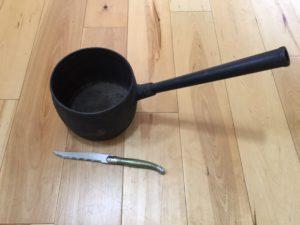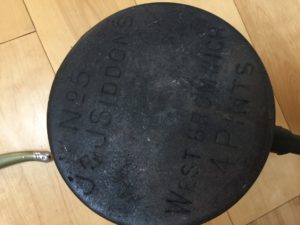 JF sent me a heavy cast iron gypsy pot for cooking, a saucepan, with a VERY long hollow handle. Black, with a slight curve to the inside of the vessel, marked on the bottom “Vintage No. 5 J and J Siddons, West Bromwich, 4 pints.” Why such a long handle?
JF sent me a heavy cast iron gypsy pot for cooking, a saucepan, with a VERY long hollow handle. Black, with a slight curve to the inside of the vessel, marked on the bottom “Vintage No. 5 J and J Siddons, West Bromwich, 4 pints.” Why such a long handle?
People used a Gypsy Pot, an amazing piece of engineering, in the middle 19th century for cooking over an open fire. Sometimes they placed the pan in the hearth. The long open cast handle kept the heat from your hand, JF.
Gypsy Pot of the 18th Century
Gypsies cooked outdoors using cast iron, usually hanging large caldrons on a tripod over an open fire. They also used these saucepans to heat liquid right on a fire. People collect these gypsy pots because they function so well as a camp pot.
The J and J Siddons Foundry STILL exists in West Bromwich, Sandwell, West Midlands, in an area from 1800 or so they called The Black County. Imagine this area called the heartland of the iron foundry universe with hundreds of chimneys pouring black smoke from the coal needed to “found.” These days Andrew Siddons runs the business mainly providing construction parts in iron. He tells with pride of the air quality control of HIS era. His great great great grandfather founded the foundry in 1818 with a brother. They called it Luke and Jesse Siddons, at their quaintly named Hilltop Foundry. The next set of brothers took it over in 1846, becoming the J and J Siddons Foundry, for Jesse and Joseph Siddons. Ltd.
What else did the foundry make?
Almost everything in cast iron, notably flat and sad irons, for laundry day. You might ask, what’s the difference? Both needed heating on a stove or in an open flame to iron those clothes. The sad iron, with a rounded convex base, rolled over a pleat, less likely to burn the fabric. Both types of Siddons irons probably came with a cast iron handle, which the female (!!) of the house grasped with a thick mitt. In some cases these irons came with a detachable wooden handle that fit over the cast iron with two double hinges.
The Glue That Binds
 The Siddons Foundry made British Weights and Measures, little disks of iron placed on scales to weigh out your flour or tomatoes by the kilo. Perhaps the most interesting thing made in the mid-19th century by the Siddons Foundry was the cast iron glue pot. This came in two pots in one, and many times they didn’t separate. Called a Bain Marie, one pot held hide glue strips, melted down to a fluid state by heating the water in the outside pot. Before the advent in WW II of a universal adhesive, we HAD to use hide glues. Almost all fine woodworking, not to mention other enterprises, used hide glues.
The Siddons Foundry made British Weights and Measures, little disks of iron placed on scales to weigh out your flour or tomatoes by the kilo. Perhaps the most interesting thing made in the mid-19th century by the Siddons Foundry was the cast iron glue pot. This came in two pots in one, and many times they didn’t separate. Called a Bain Marie, one pot held hide glue strips, melted down to a fluid state by heating the water in the outside pot. Before the advent in WW II of a universal adhesive, we HAD to use hide glues. Almost all fine woodworking, not to mention other enterprises, used hide glues.
Piano makers made a piano with the glue pot set on their own little stoves, or on a coal shop stove, or heated directly in the hearth. Why did hide glues work so well? Sadly, of course, we know most of the glue came from horse carcasses. Slaughterhouses in the 1800’s dedicated themselves to horse-glue making (awful!). Hide glue doesn’t “creep,” in other words, it’s flexible and won’t crack. To this day piano makers prefer hide glue for restoration and fine craftsmen in wood. People considered Siddons Foundry premier in making these little pots and most craftsman owned a few of them in various sizes in the 19th century.
I love the shape of JF’s gypsy pot. I call it a brilliant piece of engineering because of he way the handle arcs and angles up as the heated liquid inside leverages away from the handler. Also I think it beautiful to look at, like a piece of sculpture in cast iron, invented by the Romany gypsies.
Collectors of early gypsy cast iron cookware will pay JF $200 for this pot.
Pingback: Wrought Iron Very Right - Elizabeth Appraisals
You have done some good research on J&J S. I am Andrew’s cousin…John . I have set up with Andrew a large display of antique Siddons iron ware at the factory in West Bromwich. I’m sure interested folk could phone the company and have access to the exhibition.
The company made a vast range of domestic iron ware. Common flat irons , of course , but some specialized, like gas, charcoal and heated slug irons. Sauce pans, frying pans ,cauldrons made in numerous sizes. We even offered the range enameled or japanned. Glue pots was an excellent seller as you commented in your report.
Another excellent line was the coffee grinder. Numerous sizes. Kettles of different shapes and sizes——some with brass handles. These are very collectable. Grocery shop and domestic kitchen scales were another good line. We also made commercial scales…..coal , farm produce etc
Boot/shoe scrapers………
All of the above and more is on display at the factory. The company fazed out 99% of these items in the1950s but doubled up its production of heavy and large industrial castings. The family business ( of which I am a member ), I’m pleased to say, is successful and employs a good number of professional men and women. It is a clean air company…..no smokey pollution.
Most of the display has been collected by me over 50 years and more items are with me at my home ……much to my wife’s disappointment!
Hope this short essay is interesting.
John Siddons
Thank you for sharing your family firm’s history, really interesting. I’m currently attempting to rejuvenate a 2.5 gallon cauldron/dutch oven which is proving tricky. I’m unable to currently remove the years of ‘seasoning’ and pitting but a US social media group has given some pointers that I’ll try. The pot has a copper lid (no markings or company name) – would this likely be a replacement? I’ll need to research the finishes you mentioned, just in case that explains what the metal droplets are that are forming when I’ve heated the pot up in the oven. Maybe one day I’ll head to uour museum in West Brom…..
Great information and history! What would a gypsy pot be worth with the lid complete with the brass Siddons tag riveted to it. I have both a 6 and a 7 with lids.
They are manufactured by J&J Siddons located in West Bromwich according to the information stamped on the bottom of the pots.